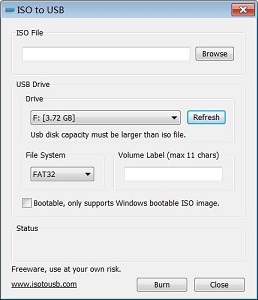

- #Iso writer for mac how to
- #Iso writer for mac for mac
- #Iso writer for mac mac os
- #Iso writer for mac install
#Iso writer for mac mac os
After that TransMac will create bootable Mac OS USB within few minutes. After that, right-click the USB Drive and select Restore with Disk Image. #Iso writer for mac for mac
Right Click on your USB drive option in TransMac and select Format Disk for Mac. Download TransMac’s latest version for Windows from this link. There are 2 Methods to Create a Bootable USB drive of Mac OS on your Windows PC. You can download it from the Apps Store or you can find Mac OS Image at ISORIVER. Then you need a working Mac OS ISO or DMG Installation Image. To get started with you require a USB drive with at least 8GB storage (16GB recommended). of working is very high and supported by Windows, Linux, and Mac OS. Reinstalling Mac OS is a time-consuming process and requires a lot of patience that’s why recommend doing this process in your free time or weekends. and cross-platform software used for writing image files as. Use of livecd-iso-to-disk on any distribution other than Fedora is unsupported and not expected to work: please use an alternative method, such as Fedora Media Writer.Macbooks or iMacs hardly require reinstallation of their Mac OS, but when they do then it’s a fairly difficult process especially if your secondary computer is Windows. Even if it happens to run and write a stick apparently successfully from some other distribution, the stick may well fail to boot. Livecd-iso-to-disk is not meant to be run from a non-Fedora system. livecd-iso-to-disk on other Linux distributions #Iso writer for mac install
If your test boot reports a corrupted boot sector, or you get the message MBR appears to be blank., you need to install or reset the master boot record (MBR), by passing -reset-mbr when writing the stick. If you get this message from fdisk, you may need to reformat the flash drive when writing the image, by passing -format when writing the stick. Partition has different physical/logical endings If you get the message Need to have a filesystem label or UUID for your USB device, you need to label the partition: dosfslabel /dev/sdX LIVE. Information: Don't forget to update /etc/fstab, if necessary. Number Start End Size Type File system Flagsġ 32.3kB 1062MB 1062MB primary fat16 boot Sector size (logical/physical): 512B/512B Welcome to GNU Parted! Type 'help' to view a list of commands. Difference between Fedora and Red Hat Enterprise Linux.Installing, Configuring and Troubleshooting MySql/MariaDB.Creating Windows virtual machines using virtIO drivers.Installing virtual operating systems with GNOME Boxes.Getting started with virtualization (libvirt).Upgrading Fedora using the DNF system upgrade.
#Iso writer for mac how to
How to Set NVIDIA as Primary GPU on Optimus-based Laptops. 
How to join an Active Directory or FreeIPA domain.

Getting started with Apache HTTP Server. Managing keyboard shortcuts for running an application in GNOME. Controlling network traffic with firewalld. Displaying a user prompt on the GNOME login screen. Understanding and administering systemd. Performing administration tasks using sudo. Configuring networking with NetworkManager CLI (nmcli). Disabling the GNOME automatic screen locking. Setting a key shortcut to run an application in GNOME. Configuring Xorg as the default GNOME session Why I recommend you to burn ISO to DVD is because current builds of Windows 10 now exceed the FAT32 file size limit and consequently you cant UEFI boot from a. Configuring X Window System using the nf file. Installing Chromium or Google Chrome browsers. The new version is also compatible with Windows 10. Installing plugins for playing movies and music Features: create, compress and expand Mac dmg disk images, built-in CD/DVD burner to burn ISO and dmg files. APT command equivalents on Fedora with DNF. If you plan on writing and using your bootable USB on Mac hardware. Securing the system by keeping it up-to-date Click on the Select Image button and choose the Ubuntu MATE. Adding or removing software repositories in Fedora. Finding and installing Linux applications. Creating and using a live installation image.






 0 kommentar(er)
0 kommentar(er)
